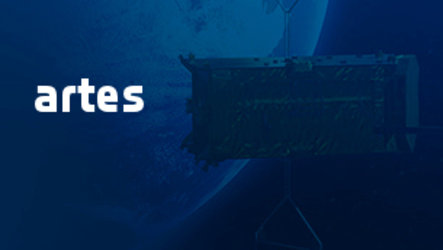Hylas
The Hylas project is developing and will demonstrate a series of innovative payload technologies and broadband data services for end users in Europe. The project will:
- construct a flexible Ka- and
Ku-band payload, based on state-of-the-art payload components that are fully configurable in orbit; - launch and operate the payload on the Hylas satellite;
- demonstrate the efficient delivery of
Ka-band broadband services with this payload and prove the case for low-cost, satellite-delivered services to underserved markets across Europe.
A key feature of Hylas is its ability to support a dynamic business environment and provide a system that can be adapted to respond to changes in market requirements for broadband and broadcast satellite services. Part of this capability is built into the inherent flexibility of the satellite payload, the rest into the design and implementation of the application-related aspects of the system, specifically the Hylas ground facilities.
Communication system with five segments
The Hylas project will deploy a complete communications system comprising five main segments:
Space Segment EADS Astrium are building the satellite, including the advanced Ku- and
The coverage uses eight spot beams that offer high gain and are therefore compatible with small and inexpensive user transmit/receive terminals. New repeater technology provides extensive service flexibility and reconfiguration in orbit. Specifically:
- Generic, Flexible Payload (GFP) equipment provides the means to flexibly allocate spectrum (bandwidth) to beams in orbit;
- ‘Flexible’ travelling wave tube amplifiers, which offer an in-orbit adjustable saturated output power at near-constant efficiency, providing the means to flexibly allocate power to beams in orbit.
Control Segment Responsible for operation of the satellite, principally the routine and emergency operation of the platform and configuration and monitoring of the communications payload.

Service Segment A comprehensive
Applications Segment While broadband services for domestic and business customers form the core application for Hylas, the system is designed to ensure the easy inclusion of other communications applications such as HDTV broadcasting and data distribution services.
Support Segment Includes the provision of launch, insurance and regulatory services.
Project plan
The Hylas project started in December 2005 and the industrial contract was announced in May 2006. This was followed by an intensive design and development phase culminating in a series of Critical Design Reviews in 2007–08. The fully tested payload will be delivered for final satellite assembly, integration and test in 2009.
Following launch in mid-2010 by Arianespace, there will be a one-year demonstration phase, during which the flexibility of the payload and a series of advanced broadband applications will be demonstrated.
Keeping costs down
The Hylas mission addresses the key cost-drivers behind the delivery of satellite broadband services: the per MHz cost of satellite bandwidth and the high cost of end-user equipment.
These will be minimised through the use of
Principal benefits
The project’s main benefits are two-fold. The development of the GFP equipment carried by the satellite offers the potential to simplify future satellite payloads greatly by enabling them to be built with highly configurable off-the-shelf components, reducing the need for high levels of bespoke design.
From a service perspective, Hylas will, for the first time in Europe, enable high-quality broadband services to be delivered at a cost comparable with terrestrial services, such as digital subscriber line, for consumers and small businesses alike.
Project status: 15 October 2009
Space Segment Payload integration has been completed. The satellite is being readied to receive the repeater panels shipped from Astrium UK in Portsmouth, UK.
Control Segment Inmarsat has completed the Qualification Acceptance Review of the Satellite Control Centre. Construction of the Telemetry, Tracking and Command (TT&C) antenna system has been completed and acceptance tests are now in progress. Development of Flight Operation Procedures continues in preparation for end-to-end tests between the Satellite Control Centre in London and the spacecraft test facilities in Bangalore, India, which are planned for later this year.
Service Segment Two





